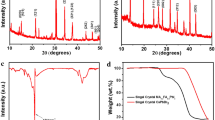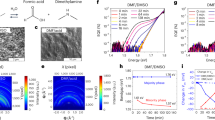Abstract
High-performance perovskite solar cell processed in ambient air is a big challenge due to the sensitivity of perovskite films to air. Many defects are generated easily at grain boundaries and in the perovskite films by conventional molecular/ion precursor solution mixing methods (i.e., solution mixing-based method), which restrict its stability in air and photovoltaic performance with most power conversion efficiency less than 15%. In this work, we develop a facile method for air-processed, highly crystalline, quasi-3D perovskite film with large grain size (over 6.6 times bigger than that from control conventional method) and improved ambient air stability by phenylethylammonium (PEA)-doped MA1−xPEAxPbI3 perovskite crystal engineering. Furthermore, benefiting from PEA+ doping and crystal engineering, the trap density decreases 50% compared with control. Consequently, with the optimal concentration of PEA doping, the power conversion efficiency increases from 15.6% for conventional solution mixing-based perovskite solar cells to 17.6% for crystal engineering-based ones with significantly improved moisture stability. The perovskite crystal engineering-based solar cells without any encapsulation retain 75% of the initial performance after 30-day storage in ambient air under a relative humidity of 50 ± 10%, and two times faster degradation rate is observed for control, conventional solution mixing-based perovskite solar cells when compared with crystal engineering-based ones.






Similar content being viewed by others
References
Frost JM, Butler KT, Brivio F et al (2014) Atomistic origins of high-performance in hybrid halide perovskite solar cells. Nano Lett 14:2584–2590
Koh TM, Fu K, Fang Y et al (2013) Formamidinium-containing metal-halide: an alternative material for near-IR absorption perovskite solar cells. J Phys Chem C 118:16458–16462
Green MA, Hishikawa Y, Warta W et al (2017) Solar cell efficiency tables (version 50). Prog Photovolt Res Appl 25:668–676
Kim W, Jung MS, Lee S et al (2017) Oriented grains with preferred low-Angle grain boundaries in halide perovskite films by pressure-induced crystallization. Adv Energy Mater 8:1706329
Lee YI, Jeon NJ, Kim BJ et al (2017) A low-temperature thin-film encapsulation for enhanced stability of a highly efficient perovskite solar cell. Adv Energy Mater 8:1701928
Dou L, Yang YM, You J et al (2014) Solution-processed hybrid perovskite photodetectors with high detectivity. Nat Commun 5:5404
Lee Y, Kwon J, Hwang E et al (2015) High-performance perovskite-graphene hybrid photodetector. Adv Mater 27:41–46
Fang Y, Dong Q, Shao Y et al (2015) Highly narrowband perovskite single-crystal photodetectors enabled by surface-charge recombination. Nat Photon 9:679–686
Tan ZK, Moghaddam RS, Lai ML et al (2014) Bright light-emitting diodes based on organometal halide perovskite. Nat Nanotechnol 9:687–692
Cho H, Kim YH, Park M-H et al (2015) Overcoming the electroluminescence efficiency limitations of perovskite light-emitting diodes. Science 350:1222–1225
Kim YH, Cho H, Heo JH et al (2015) Multicolored organic/inorganic hybrid perovskite light-emitting diodes. Adv Mater 27:1248–1254
Kang SM, Jang S, Lee JK et al (2016) Moth-Eye TiO2 layer for improving light harvesting efficiency in perovskite solar cells. Small 12:2443–2449
Im JH, Jang IH, Pellet N et al (2014) Growth of CH3NH3PbI3 cuboids with controlled size for high-efficiency perovskite solar cells. Nat Nanotechnol 9:927–932
Yang WS, Park BW, Jung EH et al (2017) Iodide management in formamidinium-lead-halide–based perovskite layers for efficient solar cells. Science 356:1376–1379
Lee J-W, Kim D-H, Kim H-S et al (2015) Formamidinium and cesium hybridization for photo- and moisture-stable perovskite solar cell. Adv Energy Mater 5:1501310
Rong Y, Hu Y, Mei A et al (2018) Challenges for commercializing perovskite solar cells. Science 361:1214
Saliba M, Matsui T, Seo JY et al (2016) Cesium-containing triple cation perovskite solar cells: improved stability, reproducibility and high efficiency. Energy Environ Sci 9:1989–1997
Dang Y, Liu Y, Sun Y et al (2015) Bulk crystal growth of hybrid perovskite material CH3NH3PbI3. CrystEngComm 17:665–670
Dunlap-Shohl WA, Daunis TB, Wang X et al (2018) Room-temperature fabrication of a delafossite CuCrO2 hole transport layer for perovskite solar cells. J Mater Chem A 6:469–477
You J, Meng L, Song TB et al (2016) Improved air stability of perovskite solar cells via solution-processed metal oxide transport layers. Nat Nanotechnol 11:75–81
Lou Y-H, Xu M-F, Wang Z-K et al (2013) Dual roles of MoO3-doped pentacene thin films as hole-extraction and multicharge-separation functions in pentacene/C60 heterojunction organic solar cells. Appl Phys Lett 102:113305
Zhu Z, Chueh CC, Li N et al (2017) Realizing efficient lead-free formamidinium tin triiodide perovskite solar cells via a sequential deposition route. Adv Mater 30:1703800
Long M, Zhang T, Chai Y et al (2016) Nonstoichiometric acid-base reaction as reliable synthetic route to highly stable CH3NH3PbI3 perovskite film. Nat Commun 7:13503
Chen H, Ye F, Tang W et al (2017) A solvent- and vacuum-free route to large-area perovskite films for efficient solar modules. Nature 550:92–95
Burschka J, Pellet N, Moon SJ et al (2013) Sequential deposition as a route to high-performance perovskite-sensitized solar cells. Nature 499:316–319
Song X, Wang W, Sun P et al (2015) Additive to regulate the perovskite crystal film growth in planar heterojunction solar cells. Appl Phys Lett 106:033901
Xue Q, Chen G, Liu M et al (2016) Improving film formation and photovoltage of highly efficient inverted-type perovskite solar cells through the incorporation of new polymeric hole selective layers. Adv Energy Mater 6:1502021
Li M, Chao Y-H, Kang T et al (2016) Enhanced crystallization and stability of perovskites by a cross-linkable fullerene for high-performance solar cells. J Mater Chem A 4:15088–15094
Xiao M, Huang F, Huang W et al (2014) A fast deposition-crystallization procedure for highly efficient lead iodide perovskite thin-film solar cells. Angew Chem Int Ed Engl 53:9898–9903
Liang P-W, Chueh C-C, Xin X-K et al (2015) High-performance planar-heterojunction solar cells based on ternary halide large-band-gap perovskites. Adv Energy Mater 5:1400960
Liu D, Kelly TL (2013) Perovskite solar cells with a planar heterojunction structure prepared using room-temperature solution processing techniques. Nat Photon 8:133–138
Chen W, Wu Y, Liu J et al (2015) Hybrid interfacial layer leads to solid performance improvement of inverted perovskite solar cells. Energy Environ Sci 8:629–640
Mei A, Li X, Liu L et al (2014) A hole-conductor–free, fully printable mesoscopic perovskite solar cell with high stability. Science 345:295–298
Saparov B, Mitzi DB (2016) Organic-inorganic perovskites: structural versatility for functional materials design. Chem Rev 116:4558–4596
Yan K, Long M, Zhang T et al (2015) Hybrid halide perovskite solar cell precursors: colloidal chemistry and coordination engineering behind device processing for high efficiency. J Am Chem Soc 137:4460–4468
Jiang L-L, Wang Z-K, Li M et al (2017) Passivated perovskite crystallization via g-C3N4 for high-performance solar cells. Adv Funct Mater 28:1705875
Li Z, Zhang C, Shao Z et al (2018) Controlled surface decomposition derived passivation and energy-level alignment behaviors for high performance perovskite solar cells. J Mater Chem A 6:9397–9401
Cao DH, Stoumpos CC, Farha OK et al (2015) 2D homologous perovskites as light-absorbing materials for solar cell applications. J Am Chem Soc 137:7843–7850
Grancini G, Roldan-Carmona C, Zimmermann I et al (2017) One-Year stable perovskite solar cells by 2D/3D interface engineering. Nat Commun 8:15684
Zhang X, Ren X, Liu B et al (2017) Stable high efficiency two-dimensional perovskite solar cells via cesium doping. Energy Environ Sci 10:2095–2102
Tsai H, Nie W, Blancon JC et al (2016) High-efficiency two-dimensional Ruddlesden-Popper perovskite solar cells. Nature 536:312–316
Wang Z, Lin Q, Chmiel FP et al (2017) Efficient ambient-air-stable solar cells with 2D–3D heterostructured butylammonium-caesium-formamidinium lead halide perovskites. Nat Energy 2:17135
Smith IC, Hoke ET, Solis-Ibarra D et al (2014) A layered hybrid perovskite solar-cell absorber with enhanced moisture stability. Angew Chem Int Ed Engl 53:11232–11235
Quan LN, Yuan M, Comin R et al (2016) Ligand-stabilized reduced-dimensionality perovskites. J Am Chem Soc 138:2649–2655
Bai Y, Xiao S, Hu C et al (2017) Dimensional engineering of a graded 3D–2D halide perovskite interface enables ultrahigh Voc enhanced stability in the p-i-n photovoltaics. Adv Energy Mater 7:1701038
Chen P, Bai Y, Wang S et al (2018) In Situ growth of 2D perovskite capping layer for stable and efficient perovskite solar cells. Adv Funct Mater 28:1706923
Liu Y, Yang Z, Cui D et al (2015) Two-Inch-Sized perovskite CH3 NH3 PbX3 (X = Cl, Br, I) crystals: growth and characterization. Adv Mater 27:5176–5183
Nie W, Tsai H, Asadpour R et al (2015) High-efficiency solution-processed perovskite solar cells with millimeter-scale grains. Science 347:522–525
Jeon NJ, Noh JH, Yang WS et al (2015) Compositional engineering of perovskite materials for high-performance solar cells. Nature 517:476–480
Bi D, Tress W, Dar MI et al (2016) Efficient luminescent solar cells based on tailored mixed-cation perovskites. Sci Adv 2:1501170
Li N, Zhu Z, Chueh C-C et al (2017) Mixed cation FAxPEA1−xPbI3 with enhanced phase and ambient stability toward high-performance perovskite solar cells. Adv Energy Mater 7:1601307
You S, Wang H, Bi S et al (2018) A biopolymer heparin sodium interlayer anchoring TiO2 and MAPbI3 enhances trap passivation and device stability in perovskite solar cells. Adv Mater 30:1706924
Liu D, Zhou W, Tang H et al (2018) Supersaturation controlled growth of MAFAPbI3 perovskite film for high efficiency solar cells. Sci China Chem 61:1278–1284
Edri E, Kirmayer S, Kulbak M et al (2014) Chloride inclusion and hole transport material doping to improve methyl ammonium lead bromide perovskite-based high open-circuit voltage solar cells. J Phys Chem Lett 5:429–433
Bube RH (1962) Trap density determination by space-charge-limited currents. J Appl Phys 33:1733–1737
Liu Z, Hu J, Jiao H et al (2017) Chemical reduction of intrinsic defects in thicker heterojunction planar perovskite solar cells. Adv Mater 29:1606774
Li C, Tscheuschner S, Paulus F et al (2016) Iodine migration and its effect on hysteresis in perovskite solar cells. Adv Mater 28:2446–2454
Reenen S, Kemerink M, Snaith HJ (2015) Modeling anomalous hysteresis in perovskite solar cells. J Phys Chem Lett 6:3808–3814
Yuan Y, Huang J (2016) Ion migration in organometal trihalide perovskite and its impact on photovoltaic efficiency and stability. Acc Chem Res 49:286–293
Acknowledgements
This work is supported by the National Key Research and Development Program of China (No.2016YFB0700702), the Natural Science Foundation of China (51502101) and the National Basic Research Program of China (No. 2015CB258400). We also thank the testing center of Huazhong University of Science and Technology for SEM, XRD, PL, UV and FTIR measurements.
Author information
Authors and Affiliations
Corresponding author
Additional information
Publisher's Note
Springer Nature remains neutral with regard to jurisdictional claims in published maps and institutional affiliations.
Electronic supplementary material
Below is the link to the electronic supplementary material.
Rights and permissions
About this article
Cite this article
Ding, M., Sun, L., Chen, X. et al. Air-processed, large grain perovskite films with low trap density from perovskite crystal engineering for high-performance perovskite solar cells with improved ambient stability. J Mater Sci 54, 12000–12011 (2019). https://doi.org/10.1007/s10853-019-03768-2
Received:
Accepted:
Published:
Issue Date:
DOI: https://doi.org/10.1007/s10853-019-03768-2




